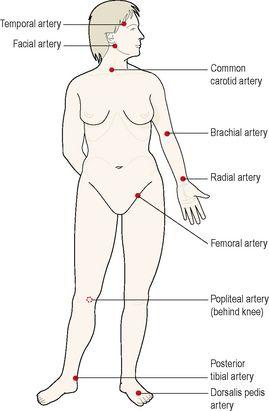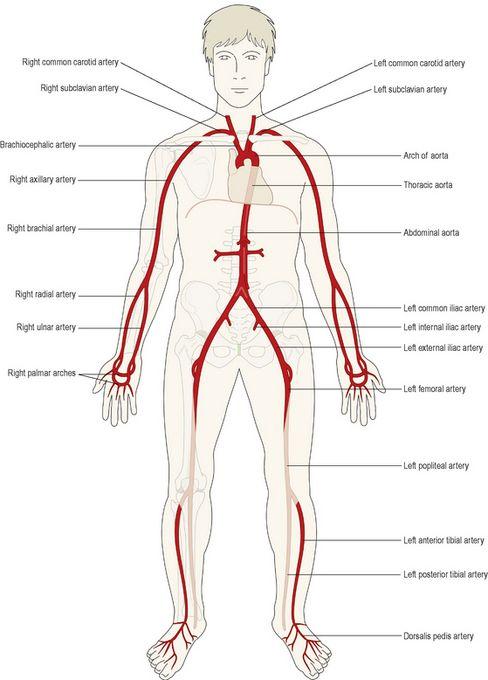Ross & Wilson Anatomy and Physiology in Health and Illness (44 page)
Read Ross & Wilson Anatomy and Physiology in Health and Illness Online
Authors: Anne Waugh,Allison Grant
Tags: #Medical, #Nursing, #General, #Anatomy

list the main sites on the body surface where the pulse is detected
describe the main factors affecting the pulse.
The pulse is a wave of distension and elongation felt in an artery wall each time the left ventricle ejects blood into the system. Each contraction of the left ventricle forces about 60 to 80 millilitres of blood through the already full aorta and into the arterial system. The aortic pressure wave is transmitted through the arterial system and can be felt at any point where a superficial artery can be pressed gently against a bone (
Fig. 5.27
). The number of pulse beats per minute normally represents the heart rate and varies considerably in different people and in the same person at different times. An average of 60 to 80 is common at rest. Information that may be obtained from the pulse includes:
•
the rate
at which the heart is beating
•
the regularity
of the heartbeat – the intervals between beats should be equal
•
the volume or strength
of the beat – it should be possible to compress the artery with moderate pressure, stopping the flow of blood; the compressibility of the blood vessel gives some indication of the blood pressure and the state of the blood vessel wall
•
the tension
– the artery wall should feel soft and pliant under the fingers.
Figure 5.27
The main pulse points.
Factors affecting the pulse
In health, the pulse rate and the heart rate are identical. Factors influencing heart rate are summarised on
page 86
. In certain circumstances, the pulse may be less than the heart rate. This may occur, for example, if:
•
the arteries supplying the peripheral tissues are narrowed or blocked and the blood therefore is not pumped through them with each heartbeat. Provided enough blood is reaching an extremity to nourish it, it will remain pink in colour and warm, even if the pulse cannot be felt
•
there is some disorder of cardiac contraction, e.g. atrial fibrillation (
p. 122
) and the heart is unable to generate enough force, with each contraction, to circulate blood to the peripheral arteries.
Circulation of the blood
Learning outcomes
After studying this section, you should be able to:
describe the circulation of the blood through the lungs, naming the main vessels involved
list the arteries supplying blood to all major body structures
describe the venous drainage involved in returning blood to the heart from the body
describe the arrangement of blood vessels relating to the portal circulation.
Although circulation of blood round the body is continuous (
Fig. 5.17
) it is convenient to describe it in two parts:
•
pulmonary circulation
•
systemic or general circulation (
Figs 5.28
and
5.29
).



